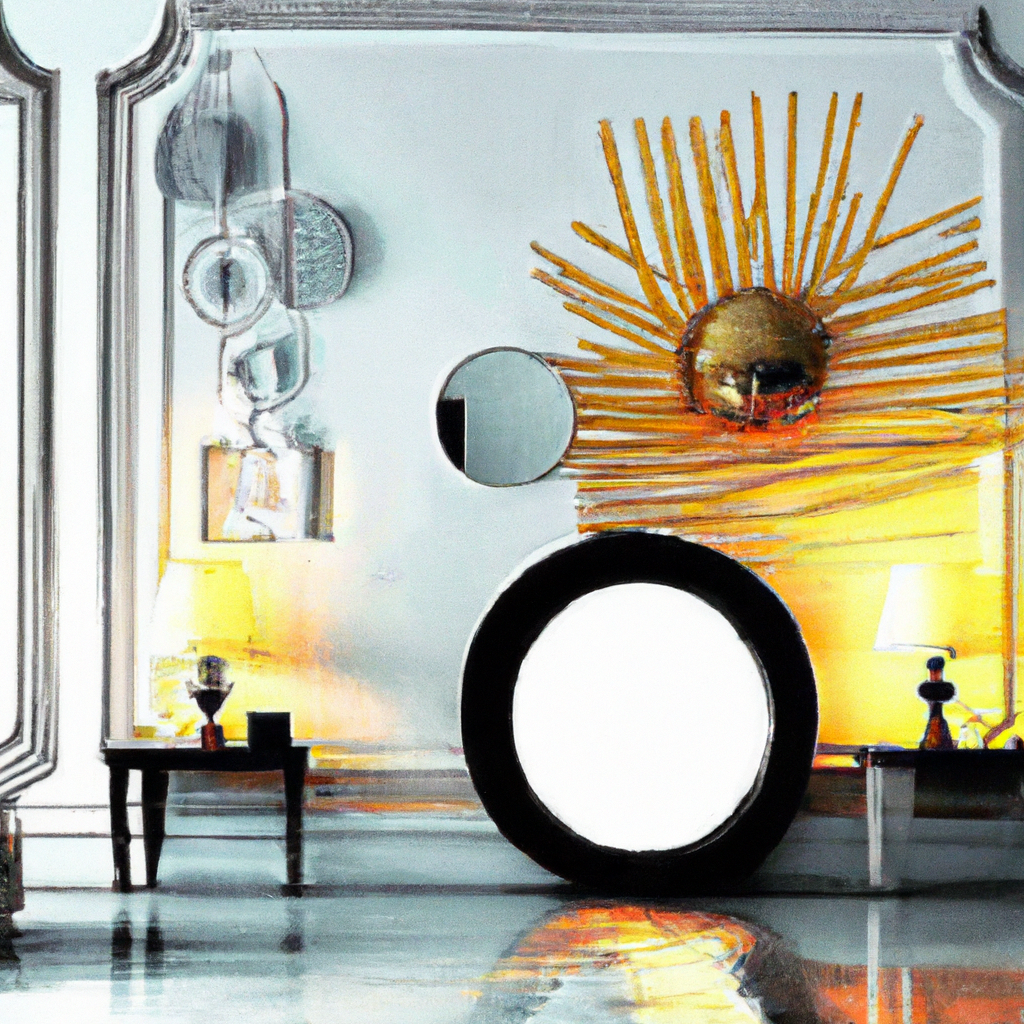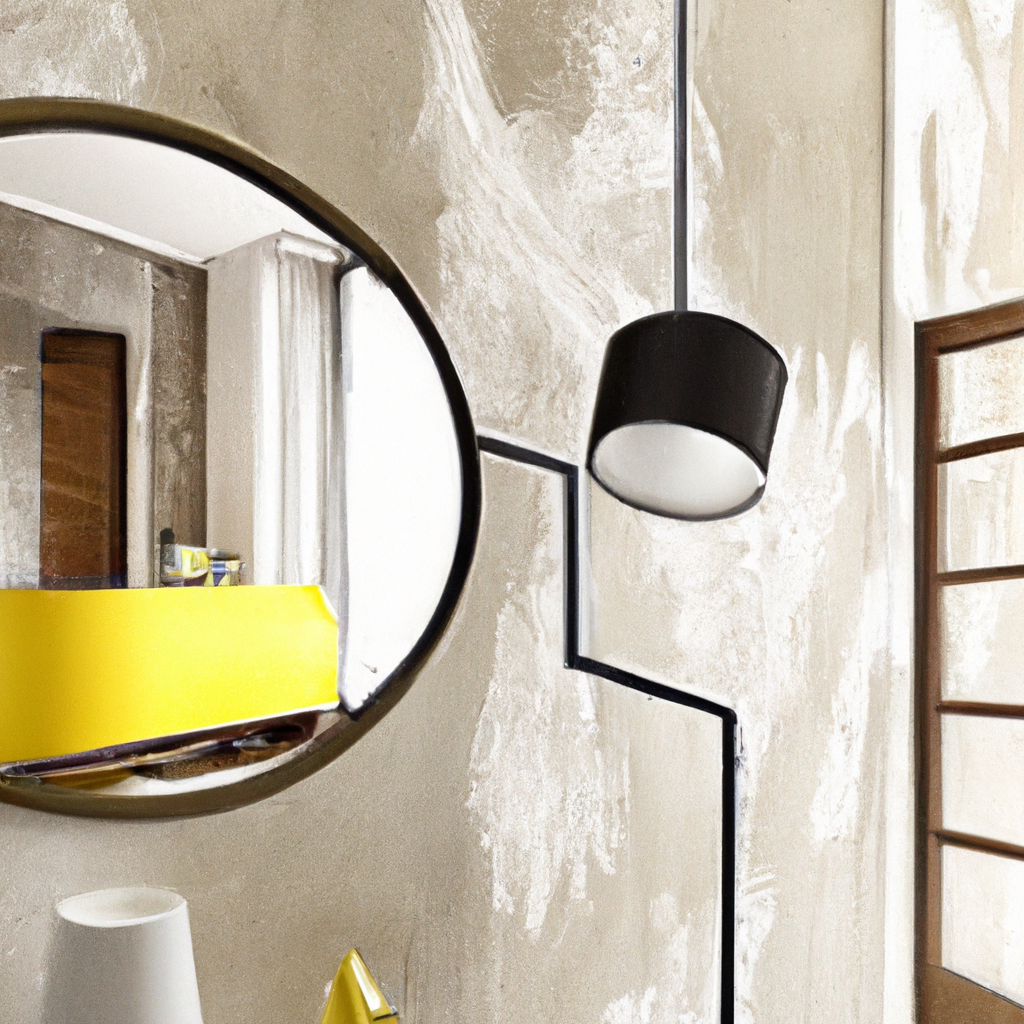
When it comes to designing your home, one important aspect to consider is how mirrors can impact the perception of space. Mirrors have the incredible ability to create optical illusions, making a room feel larger and brighter. By strategically placing mirrors in your home, you can enhance the overall design, maximize natural light, and create an illusion of depth and openness. Whether you’re looking for house inspirations, residential interior ideas, or homestyle designs, understanding the role of mirrors in the perception of space can greatly influence your home’s aesthetic and atmosphere.
1. Mirrors and their impact on space perception
Mirrors have long been recognized for their ability to transform the perception of space within a room or an entire home. By harnessing the reflective properties of glass, mirrors have the power to enhance the visual appeal and functionality of any space. Whether it’s a small apartment, a grand living room, or a cozy bedroom, mirrors can create an illusion of depth, expand small spaces, add brightness, and introduce visual interest. In this article, we will explore the various ways in which mirrors can impact space perception and the techniques to maximize their effectiveness.
1.1 Reflection and illusion of depth
One of the primary effects of mirrors on space perception is the creation of an illusion of depth. When strategically placed, mirrors reflect visual elements, including furniture, decorative objects, and architectural features, giving the perception that the space extends beyond its physical boundaries. By bouncing light around the room, mirrors can make a space feel larger and more open. Additionally, mirrors can create the impression of a doorway or window where none exists, further enhancing the sense of depth and expanding the visual boundaries of the space.
1.2 Expanding small spaces
For those with limited square footage, mirrors can be a game-changer. Small apartments and compact rooms can often feel cramped, but mirrors can help combat this issue. By strategically positioning mirrors in small spaces, you can visually expand the area, making it feel more open and spacious. Mirrors placed opposite windows or in narrow hallways can reflect natural light, amplifying the brightness and creating an airy and inviting atmosphere. The use of mirrors in small spaces can make them appear larger than they actually are, providing a sense of freedom and alleviating any feelings of claustrophobia.
1.3 Creating the illusion of additional space
Mirrors have the remarkable ability to create the illusion of additional space where there is none. In rooms with limited square footage, such as bathrooms or powder rooms, mirrors can be utilized to make the space feel larger and more expansive. By placing a large mirror on a wall or using mirrored tiles, you can visually double the perceived size of the room. This optical trick works by reflecting the existing space and bouncing light around, creating the illusion of a larger area. This technique can be particularly useful in tight quarters where increasing the physical size of the space may not be feasible.
1.4 Enhancing natural light and brightness
Natural light plays a crucial role in the ambiance and visual appeal of any space. Mirrors can be used to maximize the impact of natural light by strategically placing them to reflect sunlight or artificial lighting sources. When a mirror is placed opposite a window, it reflects and distributes the incoming light throughout the room, brightening the space and eliminating dark corners. This technique is especially useful in rooms lacking in natural light or those with limited windows. By enhancing the brightness, mirrors can create a welcoming and vibrant atmosphere, making a room feel more spacious and inviting.
1.5 Adding visual interest and depth to a room
In addition to their functional purposes, mirrors can be powerful design elements that add visual interest and depth to a room. The reflective surface of mirrors can create captivating and dynamic visual effects, especially when combined with unique shapes, frames, or finishes. By incorporating mirrors with interesting frames or geometric designs, you can introduce a focal point in a room, drawing the eye and adding personality to the space. Mirrors can also reflect and amplify existing architectural features or artwork, enhancing the overall aesthetic appeal and creating a more visually stimulating environment.
2. Mirror placement and techniques for space enhancement
The placement of mirrors within a space is of utmost importance to maximize their impact on space enhancement. By strategically positioning mirrors and utilizing certain techniques, you can optimize their ability to create an illusion of space and enhance the overall aesthetic appeal. Let’s explore some key considerations for mirror placement and techniques for space enhancement.
2.1 Strategic positioning to maximize impact
To achieve the desired impact, mirrors should be strategically positioned in areas that will have the most significant effect on space perception. Placing mirrors opposite windows or other sources of natural light allows them to reflect the light and make the room feel brighter and more open. Positioning mirrors on walls that are perpendicular to each other can create an extended sense of depth in a room. It is also essential to consider what elements you want the mirrors to reflect, whether it’s a beautiful piece of artwork, an architectural feature, or a stunning view. By carefully considering the placement, you can ensure that the mirrors maximize their impact and enhance the overall space perception.
2.2 Using large mirrors to amplify space
Large mirrors are incredibly effective at visually expanding a space and amplifying the perception of size. Placing a sizable mirror on a wall not only creates a sense of depth, but it also reflects the surrounding elements, making the room appear more expansive. A floor-to-ceiling mirror can be particularly impactful, giving the illusion of an extended vertical dimension in a room. By incorporating large mirrors, you can create a bold statement piece while simultaneously transforming the perception of the space, making it feel airier and more voluminous.
2.3 Utilizing mirrors to reflect views and outdoor spaces
If you’re lucky enough to have breathtaking views or access to an outdoor space, mirrors can help bring these elements into your interior. By strategically positioning mirrors to reflect outdoor views, you can create a seamless transition between the indoor and outdoor areas. Mirrors can capture and amplify the beauty of nature by reflecting the greenery, the sky, or even a pool. This technique not only enhances the visual appeal of the room but also creates a sense of harmony and connection with the surrounding environment, making the space feel more expansive and inviting.
2.4 Multiplying space through mirrored walls
Mirrored walls are a powerful technique to multiply the sense of space in a room. By installing mirrors on one or more walls, you can create an immersive experience where the space appears to extend infinitely. Mirrored walls are particularly effective in small, narrow rooms, such as hallways or corridors. They can elongate the space, visually stretching it and making it feel more substantial. Mirrored walls can also be utilized in larger rooms, such as living rooms or dining areas, to create a sense of grandeur and elegance. The space-enhancing effect of mirrored walls can be further enhanced by incorporating lighting fixtures or artwork that reflects in the mirrors, adding depth and visual interest.
2.5 Incorporating mirrors in furniture and accessories
Mirrors can also be incorporated into furniture and accessories to enhance space perception and add a touch of sophistication to any room. Mirrored furniture, such as dressers, sideboards, or coffee tables, can create a sense of depth and openness by reflecting the surrounding elements. These pieces can serve as functional storage solutions while adding a luxurious and glamorous touch to the space. Additionally, smaller mirrored accessories, such as decorative trays, wall-mounted mirrors, or mirrored frames, can be strategically placed to amplify the impact of natural light and create visual interest. By integrating mirrors into furniture and accessories, you can elevate the overall design aesthetic while optimizing the space-enhancing effects.

3. Mirrors as design elements in different areas of the home
Mirrors serve as versatile design elements that can be creatively incorporated into various areas of the home. From small apartments to expansive houses, mirrors can enhance the visual appeal and functionality of different spaces. Here, we will explore how mirrors can be used in specific areas of the home to create an illusion of space and elevate the overall design aesthetic.
3.1 Mirrors in small apartments and studio flats
Living in a small apartment or a studio flat doesn’t mean you have to sacrifice style or a sense of space. Mirrors can be your secret weapon in these limited square footage settings. By placing mirrors strategically, such as on the wall opposite the main entrance or on the back of a door, you can create a welcoming entryway that feels more spacious and open. Mirrored closet doors or sliding room dividers can visually expand the living area while serving as functional elements. Mirrored backsplashes in the kitchen can also make the space feel larger and reflect light, brightening up the area.
3.2 Mirrors in bedrooms and dressing rooms
Bedrooms and dressing rooms can benefit greatly from the use of mirrors. By incorporating a full-length mirror or a mirrored wardrobe door, you can create a convenient dressing area while giving the impression of a larger space. Mirrors placed on opposite walls can visually expand the bedroom, making it feel more open and airy. Additionally, mirrors can be strategically placed to reflect natural light or accentuate a beautiful view from the bedroom window, creating a serene and visually appealing environment.
3.3 Mirrors in living rooms and entertainment areas
Living rooms and entertainment areas often serve as a central gathering space in a home. Mirrors can play a crucial role in enhancing these areas, both visually and functionally. Placing a large mirror above the fireplace or on a feature wall can create a captivating focal point while expanding the perceived size of the room. Mirrored coffee tables or side tables can add a touch of elegance while reflecting the light and brightening the space. Mirrors can also be utilized to reflect artwork or decorative objects, adding depth and visual interest to the room.
3.4 Mirrors in bathrooms and powder rooms
Bathrooms and powder rooms are excellent candidates for the use of mirrors to maximize the sense of space. Mirrors placed above the vanity or spanning the entire wall can visually expand the space, making it feel more open and inviting. The inclusion of mirrors with built-in lighting fixtures can provide both functionality and an added touch of luxury. Mirrored medicine cabinets or mirrored tiles can add a modern and sleek aesthetic while amplifying the perceived size of the room.
3.5 Mirrors in entryways and foyers
The entryway or foyer sets the tone for the rest of the home, and mirrors can create a powerful first impression. Placing a large mirror in the entryway can provide a convenient last-minute check before stepping out, while also creating the illusion of a more expansive space. Mirrors can reflect natural light from surrounding windows, brightening up the area and making it feel welcoming. Additionally, mirrors can be utilized to visually extend a narrow hallway or enhance architectural features, such as an intricate staircase or an artistic light fixture.
4. Psychological effects of mirrors on space perception
Beyond the visual impact, mirrors also have psychological effects on space perception. The reflective properties of mirrors can alter perspectives, create a sense of openness and spaciousness, influence mood and emotions, promote visual balance and harmony, and even align with principles of Feng Shui. Let’s delve into the intriguing psychological effects that mirrors can have on our perception of space.
4.1 Mirror reflections and altering perspectives
Mirrors have the ability to alter our perspectives by presenting us with an altered version of reality. When we look into a mirror, we see a reflected image that appears to be at the same distance as the mirror itself. This reflection can create a sense of depth and make the space feel larger than it actually is. By providing a different viewpoint, mirrors challenge our perception of space and expand our understanding of the environment around us.
4.2 Creating a sense of openness and spaciousness
The use of mirrors can greatly contribute to creating a sense of openness and spaciousness in a room. When a mirror reflects light, it creates an illusion of increased brightness and openness. This effect can make a cramped space feel lighter and more expansive, improving the overall ambiance. The reflection of the surrounding elements and architecture amplifies the perceived size of the room, providing a feeling of freedom and airiness.
4.3 Impact on mood and emotions
Mirrors have the ability to influence our mood and emotions through the reflection of our visual surroundings. A space that is well-lit and visually appealing can positively impact our mood, and mirrors play a significant role in achieving this effect. By reflecting natural light or strategically placed artificial lighting, mirrors can create a brighter and more inviting atmosphere. The reflection of aesthetically pleasing elements, such as artwork or plants, can also evoke positive emotions and contribute to a sense of well-being.
4.4 Mirror’s influence on visual balance and harmony
Mirrors can be powerful tools in achieving visual balance and harmony within a space. By reflecting elements, such as furniture, decorative objects, or architectural features, they contribute to a sense of equilibrium and coherence. Mirrors can create a symmetrical composition by reflecting and replicating visual elements on both sides of a room. This balanced reflection promotes a feeling of harmony and stability, contributing to the overall aesthetic appeal of the space.
4.5 Mirrors and their role in Feng Shui principles
In Feng Shui, the ancient Chinese philosophy of harmonizing the energy in a space, mirrors play a significant role. Mirrors are believed to have the ability to circulate and enhance the flow of positive energy, known as qi, throughout a room or an entire home. According to Feng Shui principles, mirrors should be positioned to reflect favorable views, such as lush greenery or natural landscapes, into the space. Additionally, mirrors are used to redirect or correct any negative energy, such as sharp corners or obstructed pathways. By adhering to Feng Shui principles, mirrors can contribute to a harmonious and well-balanced space.

5. Mirror styles and designs that enhance space perception
Mirrors come in various styles and designs, each with its own unique impact on space perception. The choice of mirror style can significantly enhance the visual appeal and functionality of a space. Let’s explore some mirror styles and designs that are particularly effective in creating an illusion of space and elevating the overall design aesthetic.
5.1 Frameless mirrors for a seamless and expansive look
Frameless mirrors offer a sleek and contemporary aesthetic that seamlessly blends into any space. These mirrors have no visible frame or border, allowing them to create a sense of continuity and expansive openness. Frameless mirrors are excellent choices for small spaces or areas where you want the mirror to blend in seamlessly with the surroundings. By reflecting the colors and patterns in the room, these mirrors contribute to the overall design aesthetic without distracting from other elements.
5.2 Statement mirrors as focal points
Statement mirrors are bold and eye-catching, often featuring intricate frames or unique shapes. These mirrors serve as focal points in a room, drawing attention and adding personality to the space. When strategically placed, statement mirrors can create depth, enhance the perceived size of the room, and reflect other design elements. Whether it’s a large ornate mirror in a grand living room or a smaller geometric mirror in a minimalist setting, statement mirrors add visual interest and create a dynamic focal point.
5.3 Tinted and antique mirrors for a unique ambiance
Tinted mirrors or antique mirrors offer a touch of nostalgia and uniqueness to a space. These mirrors come in a variety of colors, such as bronze, gray, or smoked, and can add a warm or vintage ambiance to a room. Tinted mirrors can create a soft and muted reflection while enhancing the overall color palette of the space. Antique mirrors, with their aged finishes and intricate designs, can add a sense of history and character to any room. By incorporating tinted or antique mirrors, you can create a distinctive and evocative atmosphere.
5.4 Geometric and asymmetrical mirror designs
Geometric and asymmetrical mirror designs provide a contemporary and artistic touch to a space. These mirrors break away from traditional rectangular or oval shapes, introducing visually captivating lines and angles. By incorporating geometric or asymmetrical mirrors, you can create a strong visual impact and add a sense of modernity to the room. These unconventional mirror designs play with reflections, light, and shadow, enhancing the overall aesthetic appeal and creating an engaging visual experience.
5.5 Customized mirrors to fit specific spaces
Sometimes, off-the-shelf mirrors may not perfectly fit a specific space or design vision. In such cases, customized mirrors offer the flexibility to meet your exact requirements. Whether you need a mirror with a unique shape, size, or frame design, customization allows you to create a mirror that perfectly complements the space. Customized mirrors serve as functional and aesthetically pleasing solutions, ensuring that every aspect of the mirror aligns with your overall design vision.
6. Mirrors and architectural considerations
The integration of mirrors within architectural plans requires careful consideration to maximize their impact and seamlessly blend with the overall design. Architects and designers play a vital role in harnessing the potential of mirrors to enhance space perception. Let’s explore some architectural considerations when incorporating mirrors into a space.
6.1 Incorporating mirrors in architectural plans
When designing a space, architects have the opportunity to envision the integration of mirrors from the initial stages. By incorporating mirrors into architectural plans, designers can ensure that the mirrors optimally contribute to the overall design aesthetic. This may involve strategically including recessed areas or built-in niches for mirrors, specifying the ideal size and shape for each mirror, or integrating lighting fixtures to enhance the reflection of mirrors.
6.2 The role of mirrors in open floor designs
Open floor designs have become increasingly popular in modern residential architecture, and mirrors can play a significant role in enhancing these layouts. Mirrors can define separate areas within an open space, such as reflecting the dining area to create a sense of separation from the living area. By reflecting and duplicating visual elements, mirrors can establish a cohesive and harmonious flow between different areas, ensuring that the space feels interconnected and visually balanced.
6.3 Mirror installation techniques and considerations
The success of mirror placement lies not only in the design but also in the installation techniques. When installing mirrors, it is crucial to consider factors such as the wall material, weight of the mirror, and desired placement. Proper anchoring and support are essential to ensure the stability and safety of the mirrors. In addition, consideration should be given to the seamless integration of mirrors, such as concealing installation accessories or utilizing specialized adhesive techniques for frameless mirrors. By employing appropriate installation techniques, designers can achieve the desired impact while ensuring the safety and stability of the mirrors.
6.4 Maximizing mirror impact in high-ceiling spaces
High-ceiling spaces offer a unique opportunity to maximize the impact of mirrors. By placing mirrors on the upper sections of walls or integrating sizable mirrors on the ceiling, you can create breathtaking visual effects. Mirrors installed in high-ceiling spaces reflect both the vertical and horizontal dimensions, amplifying the perceived size of the room and adding a touch of grandeur. This technique is particularly effective in atriums, stairwells, or double-height living areas, where the mirrors can create a sense of drama and elegance.
6.5 Mirrors and their role in creating focal points
Mirrors can be instrumental in creating focal points within a space, drawing attention and adding visual interest. When strategically positioned, mirrors can reflect architectural features, artwork, or captivating views, making them the center of attention. Whether it’s a mirror placed behind a sculptural art piece, reflecting a beautiful chandelier, or capturing a stunning landscape, mirrors can elevate the impact of these focal points, creating a dynamic and visually rich environment.

7. Mirrors and the visual illusion of movement
Mirrors possess the unique ability to create an illusion of movement within a space. By harnessing this visual effect, designers can create dynamic and engaging environments. Let’s explore how mirrors can be used to create an illusion of movement and maximize the visual flow within a room.
7.1 Mirrors as tools for creating an illusion of movement
Mirrors can be used as powerful tools to create an illusion of movement in a space. By strategically placing mirrors to reflect different perspectives or points of view, the mirrors can simulate a sense of motion. For example, a mirror placed at the end of a hallway can reflect the opposite wall, creating the visual impression that the hallway continues beyond the mirror. Mirrors can also be placed to reflect dynamic elements, such as flowing water or a flickering fireplace, further enhancing the sense of movement within a room.
7.2 Use of mirrors in staircases and hallways
Staircases and hallways are excellent areas to incorporate mirrors to promote the visual flow and create a sense of movement. Mirrors placed strategically along a staircase can reflect the steps and balustrades, creating an intriguing visual effect and enhancing the overall grandeur of the staircase. In hallways, mirrors can reflect the length of the space, visually elongating it and making it feel more extensive. By capturing and reflecting the motion within these areas, mirrors contribute to a dynamic and visually engaging environment.
7.3 Interplay of mirrors with lighting and colors
In combination with lighting and color schemes, mirrors can play a pivotal role in creating an interplay of visual elements that suggest movement. By strategically positioning mirrors to reflect lighting fixtures or vibrant colors, the space comes alive with energy. Mirrors can capture and enhance the play of light and shadow, add depth and dimension, and create a sense of ebb and flow. When combined with dynamic lighting or contrasting colors, the mirrors can intensify the visual illusion of movement, transforming the space into a dynamic and captivating environment.
7.4 Mirrors and their effect on perceived flow in a room
The correct placement of mirrors can greatly influence the perceived flow within a room. By aligning mirrors with existing architectural lines or focal points, you can create a visual continuity that guides the eye and enhances the overall flow of the space. Mirrors can be positioned to reflect pathways or guiding elements, such as an open doorway or an arched ceiling, emphasizing the directional flow and creating a seamless transition between different areas within a room.
7.5 Creating dynamic spaces with mirrors
Mirrors have the power to create dynamic and engaging spaces, capturing the movement of light, textures, and elements. By thoughtfully incorporating mirrors into the design, you can amplify the visual impact of these dynamic elements, transforming a static room into a dynamic environment. Whether it’s reflecting the movement of a nearby water feature, capturing the flickering flames of a fireplace, or accentuating the interplay of light and shadow, mirrors allow you to create a space that is alive and constantly evolving.
8. Mirrors and their role in architectural photography
Mirrors play a significant role in architectural photography, allowing photographers to capture the essence and beauty of architectural spaces. The reflective surface of mirrors presents unique opportunities for composition, perspectives, and showcasing intricate details. Let’s explore the role of mirrors in architectural photography and how they can be utilized to create captivating imagery.
8.1 Capturing the true essence of architectural spaces
When photographing architectural spaces, mirrors allow photographers to capture the true essence of the design. By incorporating mirrors in the composition, photographers can create reflections that reveal different viewpoints or elements within the space. Mirrors can reflect the architectural details, colors, and textures, providing a comprehensive representation of the design. The use of mirrors in architectural photography enables the viewer to experience the space from various angles and appreciate the intricacies and thoughtfulness of design.
8.2 Mirror reflections in architectural photography
Mirror reflections add an extra layer of complexity and depth to architectural photography. By including mirrors in the frame, photographers can capture not only the immediate environment but also the surrounding elements reflected in the mirror’s surface. These reflections often provide a unique perspective, highlighting the relationship between the interior and exterior spaces. The reflections in mirrors can reveal hidden details, reflect natural light in unexpected ways, and create visually stunning compositions that tell a story beyond the physical space itself.
8.3 Using mirrors to enhance composition and perspectives
Mirrors offer photographers a powerful tool to enhance composition and perspectives in architectural photography. Placing mirrors strategically within the frame can lead the viewer’s eye to specific elements or create a sense of movement within the image. The reflection in the mirror can act as a leading line, guiding the viewer’s gaze and providing a dynamic and engaging composition. By utilizing mirrors, photographers have the opportunity to experiment with unique angles, depth of field, and framing, resulting in visually captivating images that showcase the architectural space in an innovative and thought-provoking manner.
8.4 Unique photography techniques involving mirrors
Photographers often explore unique techniques when utilizing mirrors in architectural photography. These techniques allow for creative and visually striking imagery that pushes the boundaries of conventional photography. For example, using multiple mirrors to create reflections within reflections can generate a mesmerizing effect, multiplying the visual impact and adding layers of complexity. Photographing through a mirror or incorporating a mirror as a prop can create a sense of intrigue and mystery, adding depth to the image. By exploring these unconventional photography techniques involving mirrors, photographers can capture architectural spaces in imaginative and captivating ways.
8.5 Showcasing architectural details through mirror imagery
Mirrors provide a captivating way to showcase intricate architectural details that might otherwise go unnoticed. By photographing specific architectural features or detailing through a mirror, photographers can draw attention to these elements and highlight their beauty. This technique allows for a magnified view of the details while adding depth and dimension to the image. Whether it’s capturing a sculptural door handle, a decorative ceiling, or an ornate window frame, mirrors enable photographers to showcase the craftsmanship and thoughtfulness of architectural design.

9. Historical and cultural significance of mirrors in space perception
Mirrors hold a rich historical and cultural significance in various civilizations, art movements, and belief systems. Throughout history, mirrors have symbolized beauty, vanity, self-reflection, and other philosophical concepts. Let’s explore the historical and cultural significance of mirrors and their role in shaping space perception.
9.1 Mirrors in ancient civilizations and their symbolism
Mirrors have been pivotal in ancient civilizations, representing profound symbolism and cultural significance. In ancient Egypt, mirrors were associated with the god Hathor, who was the goddess of beauty and love. Mirrors were buried with the dead to guide their souls to the afterlife. Ancient Romans believed that mirrors had the power to dispel evil spirits and protect against misfortune. Mirrors in ancient China were used to ward off negative energy and reflect positive qi. These ancient beliefs and practices reflect the deep-rooted significance of mirrors in space perception and their association with spirituality and protection.
9.2 Mirrors in art and literature through the ages
Artists and writers throughout history have drawn inspiration from mirrors, exploring their reflective qualities and their impact on space perception. In painting, mirrors have been utilized to enhance the perspective, add depth, or generate intriguing reflections. The famous painting “Las Meninas” by Diego Velázquez incorporates a mirror in the background, reflecting the image of the king and queen. In literature, mirrors have been used as symbols of self-reflection, identity, and the search for truth. From Lewis Carroll’s “Through the Looking-Glass” to Oscar Wilde’s “The Picture of Dorian Gray,” mirrors have played a significant role in storytelling, adding a touch of magic and introspection.
9.3 Cultural beliefs and practices related to mirrors
Throughout various cultures, mirrors have been tied to several beliefs and practices that impact space perception. In the art of Feng Shui, mirrors are used to reflect positive energy and redirect negative energy, creating a harmonious environment. In some cultures, it is believed that breaking a mirror brings bad luck or heralds seven years of misfortune. The superstition of covering mirrors during mourning is observed in many cultures, representing a respect for the deceased and preventing their spirit from becoming trapped in the mirror. These cultural beliefs and practices demonstrate the powerful influence of mirrors on space perception and their role in shaping cultural norms.
9.4 Mirrors as sources of inspiration and creativity
Mirrors have long been a source of inspiration and creativity for artists, designers, and architects. The reflective surface of mirrors challenges perception and encourages creative thinking. Artists have used mirrors to create illusions, explore different viewpoints, and experiment with reflections. Designers have drawn inspiration from mirrors to create visually stunning interiors, incorporating their reflective qualities to enhance the overall space perception. Architects have utilized mirrors to integrate nature, light, and movement into their designs, resulting in captivating and dynamic spaces. Mirrors continue to inspire innovation and creativity, pushing the boundaries of space perception in contemporary design.
9.5 Mirrors in contemporary design and their influences
Contemporary design draws from the historical and cultural significance of mirrors while embracing new possibilities and innovations. Mirrors continue to be an integral part of modern interiors, with designers utilizing them to enhance space perception, introduce visual interest, and create focal points. The functional properties of mirrors are combined with cutting-edge technologies, resulting in smart mirrors, interactive mirrors, and energy-efficient mirrored surfaces. Contemporary design embraces the flexibility and versatility of mirrors, adapting and integrating them into various styles, whether it’s minimalism, industrial, or eclectic. The influences of mirrors in contemporary design reflect a harmonious blend of tradition, innovation, and individual creativity.
10. Future trends and innovations in mirror technology
The future of mirror technology holds exciting possibilities for space perception and design. Innovations in materials, functionalities, and integration with technology are shaping the mirrors of tomorrow. Let’s explore some future trends and innovations that are set to revolutionize mirror technology.
10.1 Smart mirrors and their potential in space perception
Smart mirrors are poised to transform space perception by integrating technology into the reflective surface. These mirrors have built-in displays that can provide real-time information, such as weather updates, news, or personal health data. Smart mirrors can also be connected to smart home systems, allowing for hands-free control of lighting, heating, or security. By seamlessly merging technology with mirrors, smart mirrors have the potential to create a personalized and immersive experience that enhances space perception and functionality.
10.2 Interactive mirrors and augmented reality
Interactive mirrors combine mirrors with augmented reality (AR) technology, revolutionizing the way we interact with reflective surfaces. These mirrors can overlay digital information onto the reflection, allowing users to try on virtual apparel, experiment with different interior design options, or even virtually tour a location. Interactive mirrors can provide real-time feedback on fitness routines or skincare regimens, making them interactive and informative. By integrating AR capabilities, interactive mirrors can enhance the user experience and personalize space perception like never before.
10.3 Energy-efficient mirrored surfaces and materials
As sustainability becomes more critical in design and construction, energy-efficient mirrored surfaces and materials are gaining popularity. These mirrors utilize advanced coatings and technologies that enhance reflectivity while minimizing energy consumption. Energy-efficient mirrored surfaces can reduce the need for additional lighting, making spaces more environmentally friendly and cost-effective. New materials, such as lightweight and flexible mirrored films, are being developed, offering greater design flexibility and reduced environmental impact. The future of mirror technology lies in sustainable and energy-efficient solutions that contribute to a greener and more sustainable world.
10.4 Mirror integration with home automation systems
The integration of mirrors with home automation systems allows for seamless control and optimization of the mirror’s functionality. Mirrors can be equipped with touch-sensitive surfaces, voice recognition, or motion sensors to enable various tasks. By connecting with home automation systems, mirrors can adjust lighting levels, play music, display notifications, or even control other smart devices within the home. This integration enhances the functionality and convenience of mirrors while creating a more connected and intuitive living environment.
10.5 Experimental mirror designs pushing the boundaries
The future of mirror technology holds exciting possibilities for pushing the boundaries of design and space perception. Experimental mirror designs are exploring unconventional shapes, materials, and functionalities. These innovative mirrors challenge traditional notions of reflection and space, creating unique and thought-provoking visual experiences. By embracing experimentation and pushing the boundaries of mirror design, designers can foster creativity, spark inspiration, and ultimately redefine the way we perceive space.
In conclusion, mirrors have a profound impact on space perception and can significantly enhance the visual appeal and functionality of any room or home. Whether it’s creating an illusion of depth, expanding small spaces, reflecting views, or adding visual interest, mirrors have limitless potential to transform the way we experience our surroundings. By strategically placing mirrors, utilizing innovative designs, considering psychological effects, and embracing future technologies, designers can harness the power of mirrors to create dynamic, captivating, and visually stunning spaces. So, embrace the magic of mirrors and unlock the full potential of your living environment by discovering the transformative effects they can bring to your space perception.

